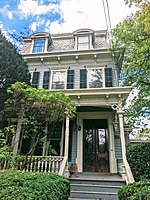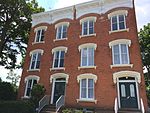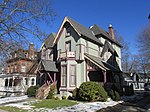Corlies–Hart–Ritter House
Dutchess County, New York Registered Historic Place stubsHouses completed in 1872Houses in Poughkeepsie, New YorkHouses on the National Register of Historic Places in New York (state)National Register of Historic Places in Poughkeepsie, New York ... and 1 more
Second Empire architecture in New York (state)

Corlies–Hart–Ritter House is a historic home located at Poughkeepsie, Dutchess County, New York. It was built about 1872, and is a 2+1⁄2-story, Second Empire style frame dwelling with a 1+1⁄2-story rear section. A garage was added about 1920. It has a fishscale slate-covered, concave-shaped mansard roof. The front façade features a full-width, one-story, flat-roofed, porch. It was home to three successive families important in local musical history.: 5 It was added to the National Register of Historic Places in 2013.
Excerpt from the Wikipedia article Corlies–Hart–Ritter House (License: CC BY-SA 3.0, Authors, Images).Corlies–Hart–Ritter House
Academy Street,
Geographical coordinates (GPS) Address Nearby Places Show on map
Geographical coordinates (GPS)
| Latitude | Longitude |
|---|---|
| N 41.695 ° | E -73.928333333333 ° |
Address
Academy Street 145
12601
New York, United States
Open on Google Maps










